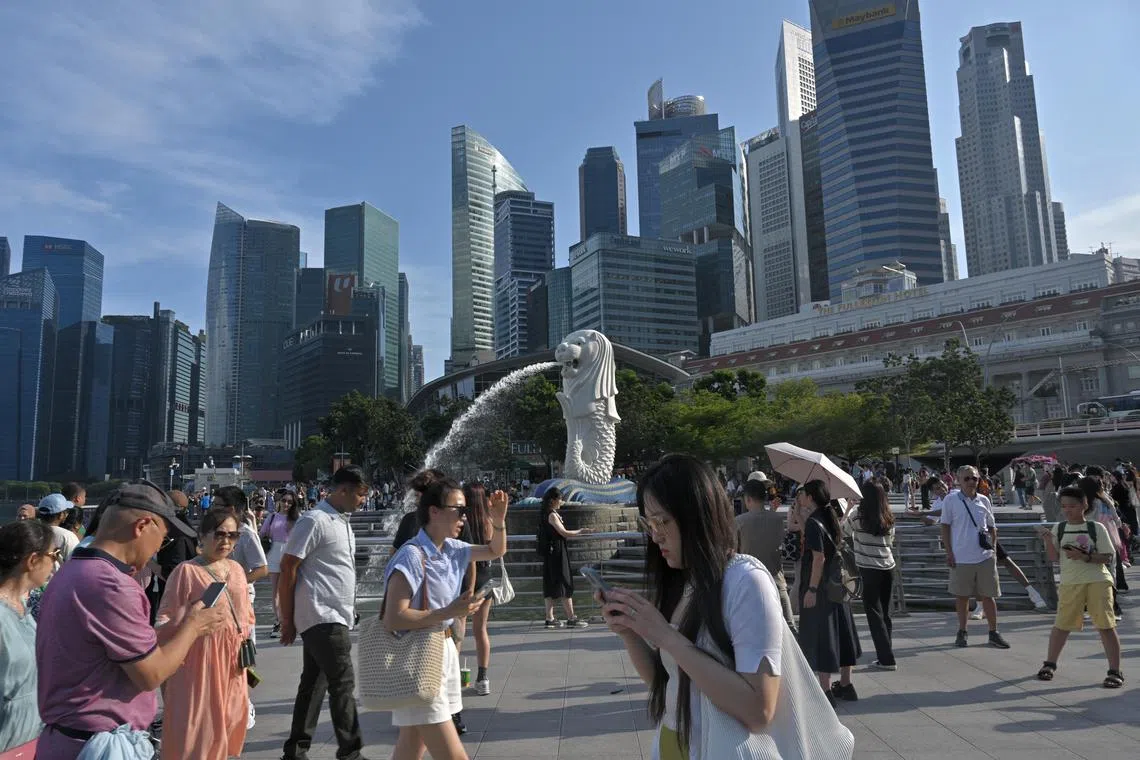Singapore hotel figures slip in Q1, with main drags in March; visitor arrivals steady
Sign up now: Get ST's newsletters delivered to your inbox

International tourist arrivals reached 4.31 million in the first quarter of 2025, according to figures from the Singapore Tourism Board.
ST PHOTO: SHINTARO TAY
Follow topic:
SINGAPORE - Hotel rates, takings and occupancy for the first quarter of 2025 fell on a yearly basis, even as the number of international arrivals was largely similar, figures from the Singapore Tourism Board (STB) showed on May 7.
Singapore hotels recorded an average room rate (ARR) of $272.63, down 3.3 per cent from $281.94 in the year-ago quarter.
The ARR grew 1.4 per cent year on year in January, but slid 3.4 per cent in February, and a steeper 7.3 per cent in March.
Other hotel industry indicators – overall hotel room revenue, revenue per available room (RevPAR) and average occupancy rate – also dipped.
This came as international visitor arrivals (IVA) were almost flat year on year. Tourist arrivals reached 4.31 million in the first quarter, up just 0.1 per cent from 4.3 million visitors in the first quarter of 2024.
This was led by a 15 per cent jump in IVA in January to 1.63 million tourists, balanced out by a 2.9 per cent fall in February to 1.38 million arrivals, and an 11.5 per cent drop in March to 1.3 million arrivals.
Of the first three months of the year, March recorded the steepest year-on-year declines across all measures.
March 2025’s IVA performance reflects seasonal patterns, said an STB spokesperson, noting the “exceptional event line-up” in the year-ago month. These included Taylor Swift’s The Eras Tour concerts, SHINee’s World VI concert and Sneaker Con S.E.A.
China was the top source of tourists in the first quarter, accounting for 831,470 visitors.
“This was mainly driven by January 2025’s strong performance due to the winter break in public schools and Chinese New Year, and on the back of the mutual visa exemption arrangement,” said the STB spokesperson.
Other top source countries in the quarter were Indonesia (640,257), Malaysia (312,218), Australia (308,124) and India (261,456).
STB noted that across source geographies, Japan posted the biggest IVA growth. Visitor numbers from the country surged 17 per cent year on year to 161,342.
The STB spokesperson highlighted that a two-year partnership with Klook launched in July 2024, which aimed to drive visitor arrivals and spending from Japan through curated leisure experiences, “successfully drove substantial bookings of Singapore experiences”.
The lower base in January to March 2024, when Japan’s outbound market was slower to recover, also amplified the growth, the spokesperson said.
Overall room revenue in the first quarter shrank 3.6 per cent year on year to $1.29 billion.
RevPAR, meanwhile, fell 4.1 per cent to $220.73.
The hotels’ average occupancy rate stood at 80.96 per cent in the first quarter, down from 81.65 per cent in the year-ago period.
Compared with the previous quarter, hotel and arrivals data picked up as a whole.
At $272.63, ARR was higher than the $270.42 in the previous quarter. Room revenue, at $1.29 billion, was up slightly from the preceding quarter’s $1.28 billion. RevPAR rose quarter-on-quarter to $220.73, from $215.76.
Occupancy was up at 80.96 per cent, from the fourth quarter of 2024’s 79.79 per cent.
Looking ahead, the STB spokesperson pointed to “an exciting line-up of events” in the next few months that it expects to drive IVA.
These include entertainment events such as the upcoming Lady Gaga concerts; major Mice (meetings, incentives, conventions and exhibitions) events such as Semicon Southeast Asia 2025; and highly anticipated sporting events such as the return of the Singapore Festival of Football.
For the full year, STB expects to receive 17 million to 18.5 million international visitors, contributing $29 billion to $30.5 billion in tourism spending. THE BUSINESS TIMES

